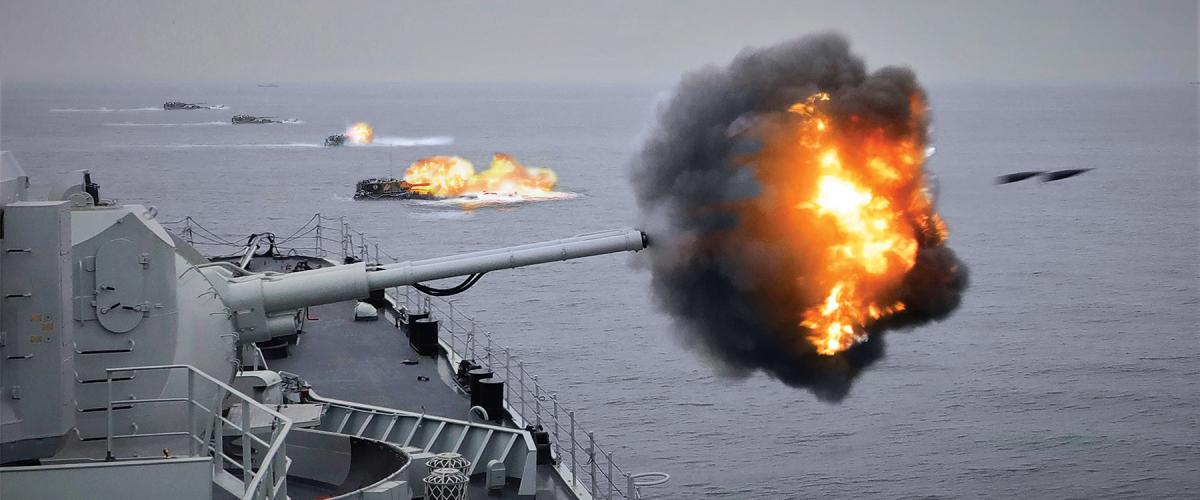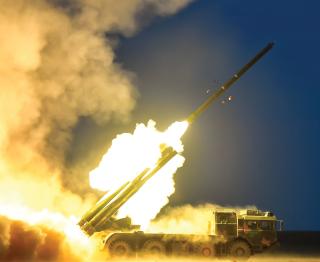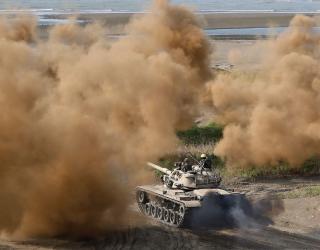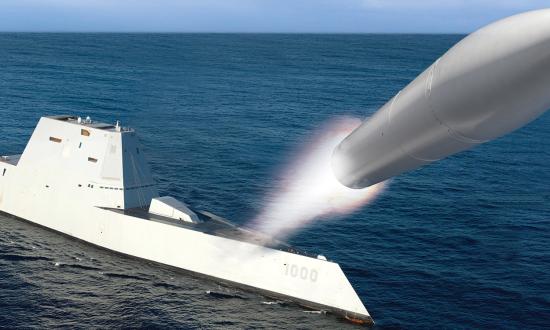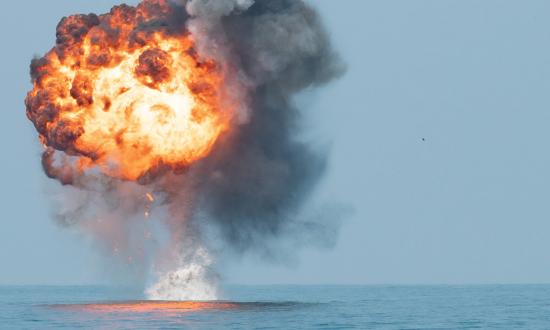This issue kicks off the third and final phase of the American Sea Power Project. This phase addresses the means portion of the “ends-ways-means” paradigm. Its goal is to generate expert domain-based assessments of naval power: areas of advantage to be exploited; areas in which the United States is at a disadvantage; and a sense of how best to apply resources in the context of a challenging great power war scenario.
Phase III will be most familiar to naval professionals because it deals with topics they work on daily: manning, training, equipping, and operating the force. It would be easy to let this phase devolve into a discussion of existing programs and procedures or current platforms. But while those are important, there is an opportunity to expand thinking beyond current programs and practices—strategic, operational, and programmatic.
The War of 2026 scenario outlined here provides a point of departure for broadened thinking about the naval aspects of a future great power war and to inform decisions regarding naval doctrine, training, procurement, and planning. It will help solidify the link between Phase III and the insights gleaned from Phases I and II of the project. In this way, the American Sea Power Project becomes not only more relevant, but also a more coherent whole.
The scenario is integral to the goals of Phase III. The war it describes is not only a struggle for regional hegemony and Taiwan, but also one with implications for the rules-based world order—with the United States trying to sustain the current one and China trying to replace it. While allies, surrogates, and third parties will be vitally involved, the essence of this competition is existential, and explicitly among China, Taiwan, and the United States.
The stakes, therefore, are enormous—much greater than at any time since the Cold War or even World War II—and carry extraordinary implications. “Business as usual” is not viable.
The scenario forms the framework for initial Phase III articles to explore the various domains of naval warfare. Note that these articles focus on warfare domains in the maritime sphere. This is distinct from Navy, Marine Corps, and Coast Guard warfare areas and communities. Authors were asked to frame their arguments within this context; however, some found it unavoidable to delve into specific communities—i.e., carrier aviation or submarines.
This scenario is but one of many possibilities, and it is neither a prediction nor the result of a wargame. It is, however, plausible and dangerous—describing some of the most demanding circumstances the nation and the Sea Services may face. Thinking clearly about this possibility will illuminate U.S. strengths and weaknesses and better inform decisions going forward. To paraphrase Herman Kahn, we must once again think about the unthinkable.1
The Road to War
Following the Taiwan presidential election of January 2024, the new president, a member of the Democratic Progressive Party, continues the nation’s drift away from the mainland. Politics are trending further toward independence. Because of global economic trends toward “reshoring” or diversifying manufacturing away from China, China’s economic growth continues to slow and even stagnate, and youth unemployment remains at or near 20 percent. President Xi Jinping’s reign continues, as does the march toward a more autocratic government with tighter domestic control. Xi increasingly stokes nationalist sentiments to mobilize support for his policies. China paints itself as the victim of international aggression to feed increasingly belligerent actions in the South China and East China Seas.
Beyond the Pacific, Chinese efforts include arming and encouraging additional Russian aggression in Europe; sealing alliances with Russia and Iran; and expanding long-standing access in Africa and South America.2
The number of near misses between Chinese military ships and aircraft and those of the United States, Japan, Taiwan, and other nations grows until, in late 2025, a collision between a People’s Liberation Army Navy (PLAN) ship and a U.S. Navy destroyer in the Taiwan Strait involves casualties on both sides and affords the spark Xi was seeking to begin the war.
The Fighting Begins
In 2026 (within the “Davidson Window”), and with little warning, China declares the start of an operation to restore the integrity of Greater China. Quickly, the People’s Liberation Army (PLA) takes control of all Taiwan’s offshore islands, the Penghus, and the southern third of Taiwan, including the port of Kaohsiung. The PLA invasion force is stalled after the initial fight and the invaders are now in “recovery,” preparing to seize the initiative. Chinese reppression in occupied zones is brutal.
Taipei’s electric and communication grids have been shut down by a combination of cyber and kinetic strikes, but physical damage to the city has not been significant. Taiwan’s air force and air defenses have been neutralized, and the PLA has air superiority over the island.
The Taiwan government is in hiding, most likely dispersed in hardened facilities. Its ability to command and control its forces is impaired, and communication with the outside world is limited.
The global economy, equity markets, and capital flows all take major hits—with significant negative impacts on national economies. Trade flows decrease rapidly—especially in the Indo-Pacific—after combat operations begin. A significant effort is underway in the United States and other countries to shore up domestic economies and reroute trade, financial, and information flows. Since more than 80 percent of global trade moves by sea, there are direct implications for naval missions. Securing friendly trade while interrupting that of the enemy will be of the highest importance.
China’s coup de main appears to be set on establishing a new political paradigm in the Asia-Pacific region.
With swift ballistic and cruise missile attacks, the PLA neutralizes the U.S. 5th Air Force in Japan, destroying most U.S. Air Force aircraft on the ground at Kadena and Misawa and heavily damaging airfield and support infrastructure. U.S. naval facilities in Yokosuka and Sasebo have been attacked and heavily damaged. Seventh Fleet ships in these ports have been sunk or heavily damaged, including the command ship USS Blue Ridge (LCC-19) and the carrier USS George Washington (CVN-73). The Seventh Fleet commander has been killed. III Marine Expeditionary Force is isolated in Okinawa with reduced means of transport.
Initial Chinese attacks do not directly target Japan Self-Defense Forces (JSDF), but attacks on U.S. forces based in Japan generate collateral damage on the JSDF and kill civilians. Japan initially declares a defense emergency and consults with the United States on next steps. After full-throated internal deliberation and in the face of peace demonstrations in major cities, the government of Japan invokes the defense clauses of the security treaty with the United States. Japan Maritime Self-Defense Force ships that were ready for sea have sortied from port. Japan is in the fight.
Tensions are high on the Korean Peninsula. Militaries on both sides of the DMZ are on full alert.
The PLA has embarked on an all-out assault in the C5ISR realm. Attacks include communications and GPS jamming, kinetic attacks on U.S. and allied command, control, and communications infrastructure in the region, and attacks on low-earth-orbit imagery satellites using high-energy lasers, jammers, and direct-ascent antisatellite weapons. U.S., Taiwanese, and allied communications and ISR assets are operating in a heavily denied environment. Chinese cyber attacks on military logistics and base infrastructure, including the nonclassified internet protocal router network, power, and communications at U.S. bases in theater, in Hawaii, and on the U.S. West Coast have slowed and impeded the movement of most classes of supply.
Suspicious cyber activity in Australia, Japan, Singapore, and the Philippines hinders internet traffic, supervisory control and data acquisition systems, and electrical power. Many protestors demand their countries stay out of the war.
China attacks U.S. military facilities on Guam with a series of long-range cruise missiles, ballistic missiles, and cyber attacks. Moderate to severe damage has been sustained at Anderson Air Force Base and Naval Base Guam. Air and naval forces can operate from Guam with risk. Patriot and Terminal High-Altitude Area Defense batteries and Aegis ballistic-missile defense ships have succeeded in shooting down many incoming missiles, but a lack of reloads is a concern.
PLAN forces have sortied from their home ports with major concentrations in the South China Sea west of Luzon, surrounding Taiwan, and some operating outside the first island chain, guarding the approaches to Taiwan. Several PLAN submarines have been detected maneuvering toward Hawaii and the U.S. West Coast.
Beyond the Pacific, Chinese efforts include arming and encouraging additional Russian aggression in Europe; sealing alliances with Russia and Iran; and expanding long-standing access in Africa and South America.3 China is encouraging Russia and Iran to take advantage of the war in the Pacific to stir up tensions and gray zone activity in the Black Sea, Eastern Europe, the Strait of Hormuz, Persian Gulf, and broader Middle East. As a result of these threats, a significant part of the U.S. military force structure cannot be deployed to the Pacific.
Chinese messaging across all media focuses on the themes of national unification, returning Taiwan to its rightful place as part of China, and putting an end to outside (U.S.) meddling. Other nations in the region are warned not to intervene in Chinese domestic disputes—siding with the United States and Taipei will result in severe consequences.
U.S. and Allied Reaction
The U.S. and allied strategic goal is to defend Taiwan, allowing it to remain autonomous, and to defeat China militarily and isolate it politically and economically.
Initial U.S. operational goals are to protect the U.S. West Coast and sea and aerial ports of debarkation; and to defend Guam and Hawaii (protect sea lines of communication to Hawaii, and deploy missile defense and antisubmarine warfare [ASW] forces in support). Subsequent operations prioritize ensuring maritime and air connectivity with Japan, Australia, the Philippines, and South Korea.
The Philippine military is on high alert and preparing to defend Luzon, but the government in Manila is nervous about taking sides.
Retaking Chinese-held territory on Taiwan is deferred for the time being, but U.S. forces have been ordered to target Chinese forces blockading and invading Taiwan to the extent possible.
Some air and naval forces are swinging to the Pacific from Europe and the Atlantic. A massive reserve call-up has been initiated.
Strategic and operational plans are being revised for what is increasingly expected to be a long and widespread war.
A major operational goal for U.S. and allied forces has been controlling movement of goods, services, and information around the world: to ensure friendly flows are rebuilt and sustained and to deny the same to China and its allies. In short, the United States must support allies, move to help Taiwan retake lost territory, and impose a maritime and air blockade on China. At the same time, it must prevent Chinese interdiction and control of the movement of U.S. and allied military forces, commercial goods, and supplies.4
Current Situation
Direct combat has been underway between Chinese and U.S. forces for a month. Using the five-phase framework of war (initial fight, recovery, seizing the initiative, the long campaign, and war termination), the United States and its allies are now in the second phase: recovery.
As is the historical norm in great power wars, it is increasingly evident that this war will last years, rather than months or weeks. Likewise, neither side was fully prepared for the sudden scope and scale of the conflict.
A central element of the war rapidly becomes a contest for control of the maritime approaches to China and sea lines of communication in the Indo-Pacific. This brings the war ashore at key points, with land-sea maneuver campaigns to control littorals, straits, islands, capes, headlands, and archipelagoes, resulting in ground force operations ashore at scale.Together with joint and combined forces, the Navy and Marine Corps are fighting a capable, determined, and fully committed enemy. The conflict already is broad and intense.
Deterrence remains of vital importance in avoiding drastic escalation and strategic attacks. The risk of nuclear weapons and weapons of mass effect—including in the space and cyber domains—must be taken into account in planning and operations. Strategic forces on both sides are at high alert. There is a potential for the use of tactical nuclear weapons at sea and ashore; and U.S. planning must account for the possible presence of such weapons, the uncertain dynamics of multilateral nuclear deterrence, and the effect of their use on U.S. forces and allies.
Both sides have initiated sea lane defense and sea control campaigns. Although the U.S. Navy planned for a contest against the PLA, it did not program forces to defend trade or ensure movement of forces and materiel within the second island chain. There is now a desperate need to defend and realign trade routes, financial flows, and information conduits.
Author Constraints and Restraints
Authors are asked to assume 2024 to 2026 force structure: U.S., Chinese, allied, and neutral.
As a result of the economic upheaval, U.S. and allied forces will be required to escort merchant shipping—particularly in the western Pacific—to keep wartime economies going in addition to escorting sea-based military logistics movements.
Consistent with its doctrine, the United States will fight the war in a joint, multidomain way. While authors consider specific domains, the scenario expects that their analysis will account for required and provided cross-domain capabilities.
At its core, the war is part of long-standing U.S.-China competition. However, in execution it will not be a bipolar U.S.-China war. It will be a “combined” war—allies, partners, surrogates, and third parties will play key roles on both sides. Preferably it will be a war of alliances from the U.S. view—that is generally seen to the advantage of the United States with its strong, vibrant, and willing partnerships. That assumption must be tempered, however, with realistic judgments of alliance and partner will, capabilities, sustainability, interoperability, levels of effort, and vulnerabilities.
China is explicitly working to break down U.S.-led alliances. Its military, economic, and diplomatic efforts have met with some success. If this strategy is not countered, there is a real prospect of the United States having to fight without full support from allies—much as Great Britain did against Germany before 1942.
Strategic, operational, and tactical planning must come to grips with how to integrate disparate capabilities and national priorities. Specifically, authors should consider how the following militaries might participate in the conflict: Japan, South Korea, Australia, the Philippines, Vietnam, and NATO.
Given that the scenario stipulates a long war, authors must consider the implications for national mobilization—industrial and societal. Mobilization is a broad topic, and it is not intended that the domain articles delve deeply into it. Rather, authors should account for the effect of mobilization (or the lack of it) on how they assess the war in their domain would evolve over the years of active combat operations.
Author Tasking: Competitive Assessment
This scenario is an opportunity for authors to consider necessary capabilities and undercutting limitations in their assigned domains. Authors are asked not to maneuver and fight, but to assess requirements, capabilities, advantages, and shortfalls. Specifically: How do you assess U.S. capabilities in your domain against parallel Chinese strengths and weaknesses? How will you employ forces in your domain? What tasks, missions, and sequence will you develop? When might you begin to take the initiative? What support will you need in your domain? From other domains? From allies and partners? Logistics and repair? What are your strengths and vulnerabilities? What, if any, capabilities are in excess? What capabilities do you need but lack? More specifically, what weapons, sensors, systems, or platforms should be produced in quantity now to prove decisive in this scenario (or a lack of which could prove fatal)?
With this scenario and guidance, Proceedings asked experts to write about: undersea warfare, strike warfare, surface warfare, mine warfare, air and missile defense, amphibious warfare, logistics, information warfare, space, and command and control. Five of those answers are in this issue, with more to come in January. These are not “cookie cutter” responses—the focus, organization, and tone of each varies. What does not vary, however, is that each provides a sobering analysis of the immense difficulty that a China-Taiwan conflict would present to U.S. naval forces.
1. Herman Kahn, Thinking About the Unthinkable (New York: Horizon Press, 1962). Kahn explores the possibility of nuclear war, how it might start, and how it might be fought. His purpose was to illuminate the terrifying aspects of such a war to deter it.
2. Richard D. Fisher Jr., “On Taiwan: What If We Only Have Six Months?” Taipei Times, 19 June 2023.
3. Fisher Jr., “On Taiwan: What If We Only Have Six Months?”
4. U.S. and allied planners have noted the vulnerability of China’s so-called “Blue Economy,” which involves every aspect of China’s maritime enterprise, including shipbuilding and supporting industry; resource extraction (including but not limited to extensive fishing operations); port infrastructure development and operations domestically and abroad; integrated maritime political operations; and naval operations and support.



